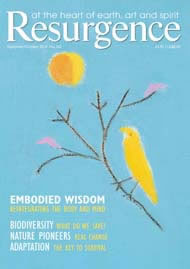On our short courses at Schumacher College we often pay a visit to Martin Crawford’s Dartington garden and, without fail, the students leave feeling inspired. I, too, learn something new on every visit and it is the same with Crawford’s new book, which deserves to become a classic – there is something of value on every page, and it seems to turn up something new each time I return to it.
Crawford divides the book into three main sections – How Forest Gardens Work, Designing Your Forest Garden, and Extra Design Elements and Maintenance – and it is lavishly illustrated with Crawford’s and Joanna Brown’s beautiful colour photographs along with line drawings by Marion Smylie-Wild. Overall, this is a wonderful piece of work, crafted with love and speaking to the spirit.
It is a visual treat, and a book that works on many layers. It contains, for example, several chapters reflecting the author’s research on the characteristics, limitations and uses of species after species. There are chapters on canopy species, shrub species, perennial and ground-cover species, annuals, biennials and climbers. Each chapter describes hundreds of plants, with a helpful summary table for each species covering size, growing conditions, uses, harvesting and storage, cooking and processing, propagation and maintenance. These chapters are interspersed with additional chapters on the design factors associated with each layer of the agro-forest.
This research-led content continues in the appendices, which provide detailed propagation tables, lists of trees and shrubs for various purposes, and month-by-month analyses of bee- and insect-attracting plants and edible species.
But this book is so much more than a research guide or growers’ almanac. It is also a passionate and authoritative exploration of the why and how of food-forest creation. It is sympathetic to the small-scale gardener, with a helpful schedule of plants suitable for smaller plots and words of wisdom on dwarf fruit trees.
Is it the perfect book on food forests? Of course there is room for improvement. This is a big, expensive book, which would suit an electronic format. With minimal redesign it would work well, or even better, online. That way it could be made searchable, more use could be made of the photography, and it could incorporate videos.
Is it a good book? Absolutely yes. Rob Hopkins, founder of the Transition Towns movement, describes this book as “the definitive manual”. I agree, and recommend it wholeheartedly. I also hope that it will one day speak to a wider audience than the committed core of growers that might constitute the original market.
It is my hope, too, that this book, because of its passion and its captivating beauty, will also speak to people who work in other fields, including business, politics and civic society. The principles of lightly managed chaos – working closely with Nature and not seeking to dominate and impose order – are good advice in the garden but also represent deeply applicable and practical advice to leaders everywhere.
Crawford relates, for example, a story about how his raspberries have migrated southwards during the time his garden has been growing. He could have spent vast amounts of energy and effort containing them, but instead he has let them be – worked with what is emerging. How different would our organisations and societies be with this kind of attentive and humble stewardship?
How different would our businesses be if we all let the raspberries head south, if we let the creative human spirit flourish rather than seeking to impose containment in the name of predictability and order? We would certainly have more attentive, less resource-intensive organisations that would be much more attuned to natural processes, and this is something we most certainly need.
This is an important book on every level. Crawford’s passion, energy and humour flow out from the pages. It is a work that embraces the practical and the profound, and the author himself is a true frontiersman, a pioneering teacher and an inspiration. Both his book and his garden are national treasures.







